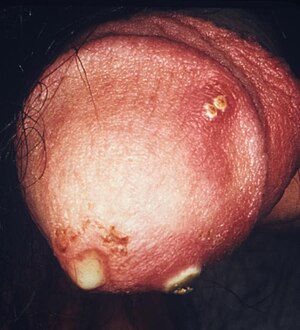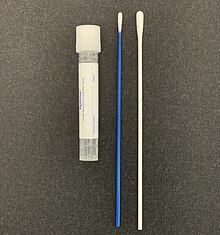Penile discharge
| Penile discharge | |
|---|---|
| Other names: Penis discharge[1] | |
 | |
| Purulent penile discharge due to gonorrhea with an overlying penile pyodermal lesion.[2] | |
| Specialty | Urology |
| Symptoms | Fluid from penis[1] |
| Causes | Gonorrhea, chlamydia, balanitis, prostatitis, epididymitis, reactive arthritis, irritation, unknown[3][4] |
| Risk factors | Uncircumcised, new sexual partner, unprotected sex[5][3] |
| Diagnostic method | Fluid culture[3] |
| Differential diagnosis | Urinary tract infection[5] |
| Treatment | Depends on the cause, though often with antibiotics[3] |
| Frequency | Common[3] |
Penile discharge is any fluid from the urethra at the end of the penis that is not urine or semen.[1] It may be purulent or bloody.[6] Associated symptoms may include burning with urination or a desire to urinate frequently.[5]
Common causes include gonorrhea, chlamydia, balanitis, prostatitis, and epididymitis.[4] Other causes include trichomoniasis, irritation, reactions to soap, and reactive arthritis.[3][5] In up to a third of cases the cause is unclear.[5] Risk factors include being sexually active under the age of 25, having a recent new sexual partner, being uncircumcised, or having unprotected sex.[3][5]
Diagnosis can be supported by a swab of the discharge for bacterial culture.[3] In gonorrhea the discharge may be white, yellow, or green.[3][7] Testing for other STIs such as HIV/AIDS, syphilis, and hepatitis C is often recommended.[3]
Treatment generally begins with antibiotics to cover the potential for gonorrhea and chlamydia.[3] Antibiotics used often include ceftriaxone and azithromycin.[3] Sexual contacts may also require treatment.[5] Penile discharge is common.[3] Mentions of penile discharge date back to at least the old Testament in Leviticus 15 (528-332 BC).[8]
Signs and symptoms
Penile discharge is liquid from the urethra at the end of the penis that is not urine or semen.[1] The dripping of clear fluid when sexually excited is normal.[1]
There may be pain or burning when passing urine, soreness inside the penis or feeling of wanting to pass urine frequently.[5]
Causes
Common causes include infections due to gonorrhea, chlamydia, or trichomoniasis.[4]
Other causes include:
- Non-specific urethritis[1]
- Acute prostatitis[1]
- Infection under the foreskin[1]
- Warts at the opening of the urethra[1]
- Herpes simplex virus ulcer at the opening of the urethra[1]
- Object in the urethra[1] or recent surgical procedure.[3]
- A bloody discharge may be a sign of urethral cancer.[3]
Risk factors include being sexually active men under the age of 25, having a recent new sexual partner, unprotected sex (without a condom), or having the presence of any sexually transmitted infection.[5]
Diagnosis

A swab of the discharge is usually performed by inserting the urethral swab into a held up penis to about half an inch and then turned before being removed and placed into the specimen container.[3] Other investigations may include tests for HIV, hepatitis and syphilis.[5]
Men who have sex with men may also need to have throat and rectal swabs.[5]
Treatment
Treatment depends on the cause and any antibiotic prescribed depends on which infection is found.[5] Spread of infection is reduced by informing sexual partners so that they can also be treated, and not having sex (including oral or anal) until tests are completed and seven days have passed after treatment.[5]
Epidemiology
Penile discharge is common.[3]
History
Mentions of penile discharge date back to at least the old Testament in Leviticus 15 (528-332 BC).[8]
References
- ↑ 1.00 1.01 1.02 1.03 1.04 1.05 1.06 1.07 1.08 1.09 1.10 "Penis Discharge". conditions.health.qld.gov.au. Queensland Government. 2017. Archived from the original on 1 May 2021. Retrieved 27 December 2020.
- ↑ "Details - Public Health Image Library(PHIL)". phil.cdc.gov. Archived from the original on 6 March 2021. Retrieved 27 December 2020.
- ↑ 3.00 3.01 3.02 3.03 3.04 3.05 3.06 3.07 3.08 3.09 3.10 3.11 3.12 3.13 3.14 3.15 3.16 Kahan, Scott; Miller, Redonda; Smith, Ellen G. (2008). "126. Penile Discharge". Signs and Symptoms. Lippincott Williams & Wilkins. ISBN 978-0-7817-7043-9. Archived from the original on 2021-04-29. Retrieved 2020-12-27.
- ↑ 4.0 4.1 4.2 Dains, Joyce E.; Baumann, Linda Ciofu; Scheibel, Pamela (2018). "27. Penile Discharge". Advanced Health Assessment & Clinical Diagnosis in Primary Care E-Book (6th ed.). Elsevier Health Sciences. p. 378. ISBN 978-0-323-59454-7. Archived from the original on 2021-08-28. Retrieved 2020-12-28.
- ↑ 5.00 5.01 5.02 5.03 5.04 5.05 5.06 5.07 5.08 5.09 5.10 5.11 5.12 "Urethritis and Urethral Discharge in Men". patient.info. Archived from the original on 15 November 2017. Retrieved 6 December 2014. Cite error: Invalid
<ref>tag; name "Patient2014" defined multiple times with different content - ↑ Swartz, Mark H. (2014). Textbook of Physical Diagnosis E-Book: History and Examination. Elsevier Health Sciences. p. 478. ISBN 978-0-323-22507-6. Archived from the original on 2021-08-28. Retrieved 2020-12-28.
- ↑ 7.0 7.1 "Gonorrhea - CDC Fact Sheet". cdc.gov. Archived from the original on 16 December 2016. Retrieved 6 December 2014.
- ↑ 8.0 8.1 Morris, Larry A. (1997). The Male Heterosexual. SAGE. p. 170. ISBN 978-0-8039-5640-7. Archived from the original on 2021-08-28. Retrieved 2020-12-28.